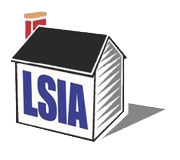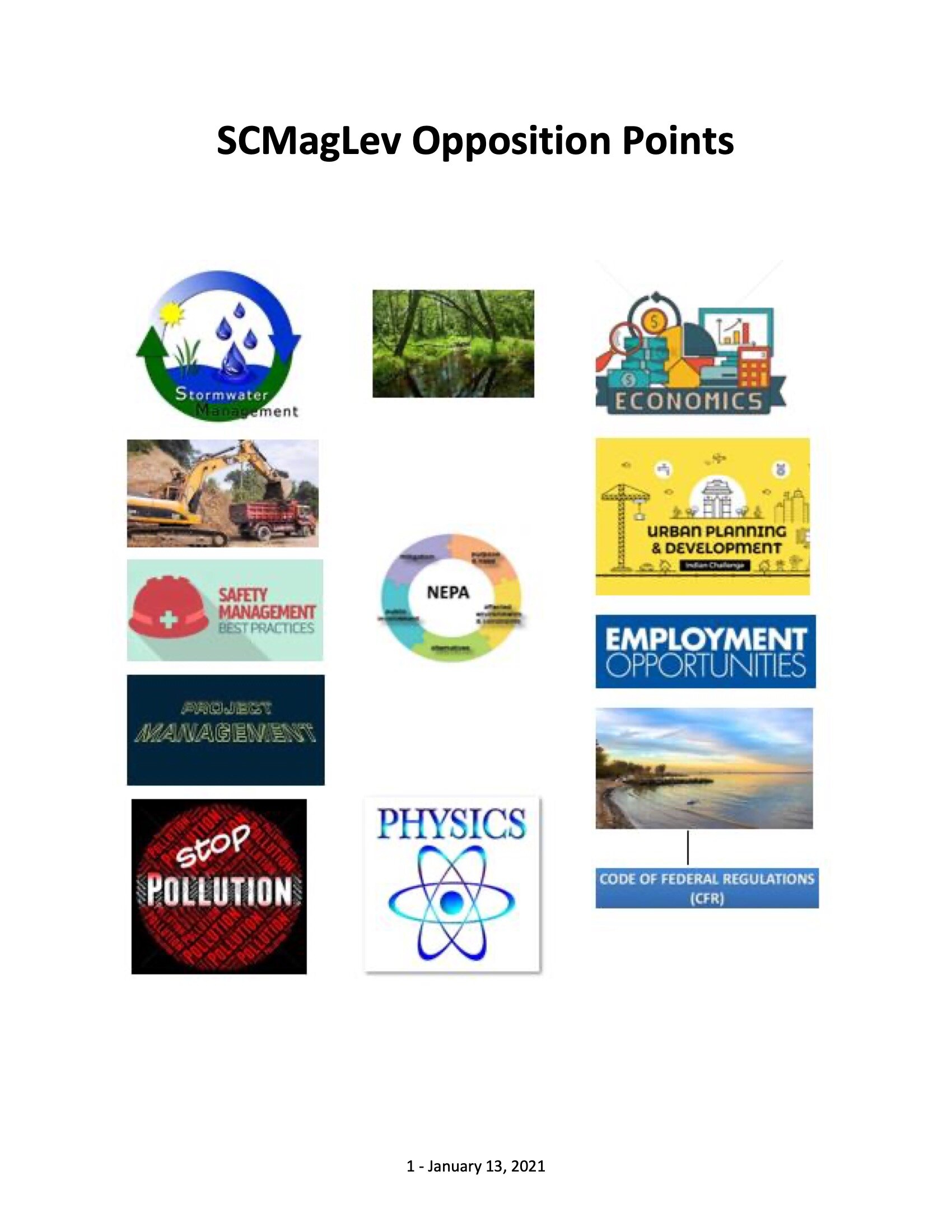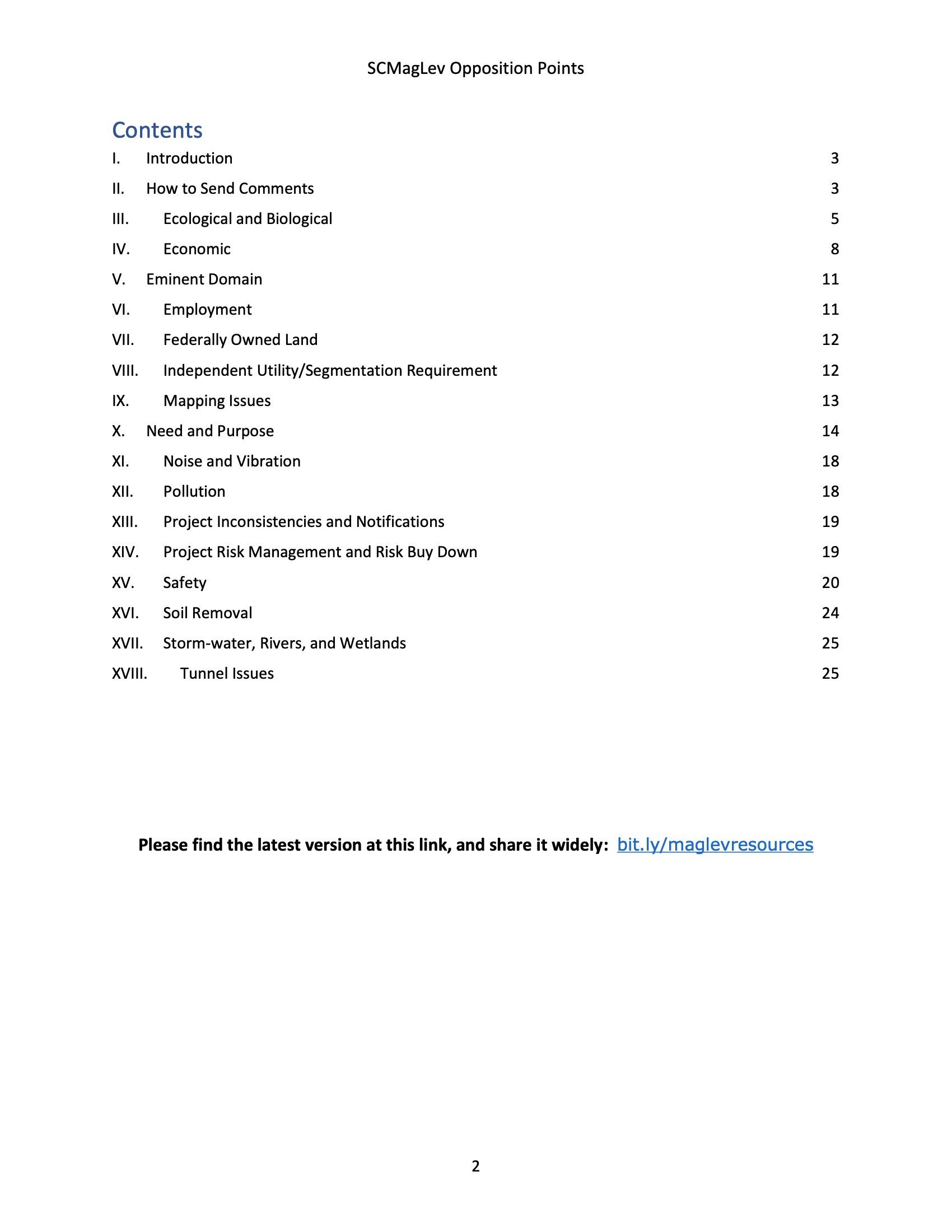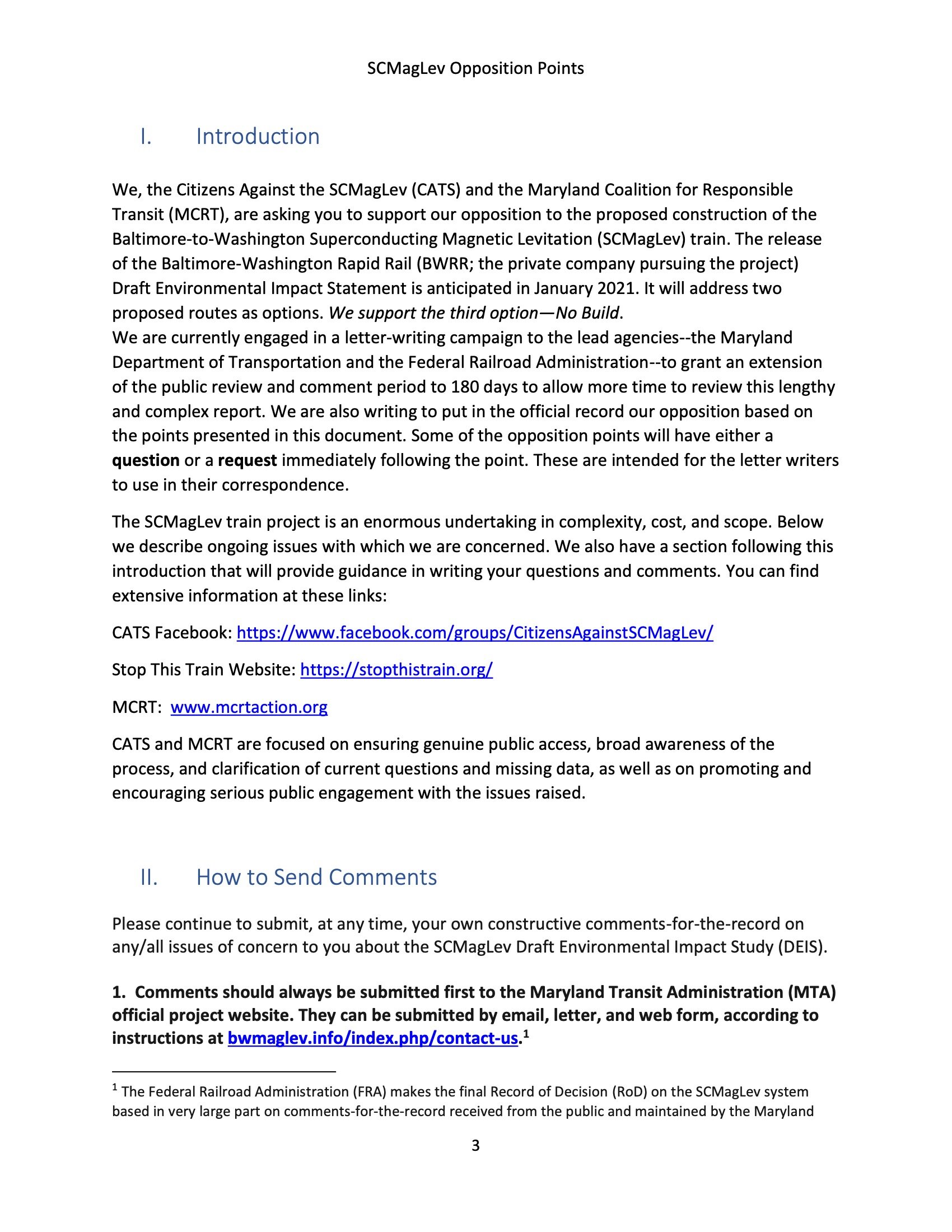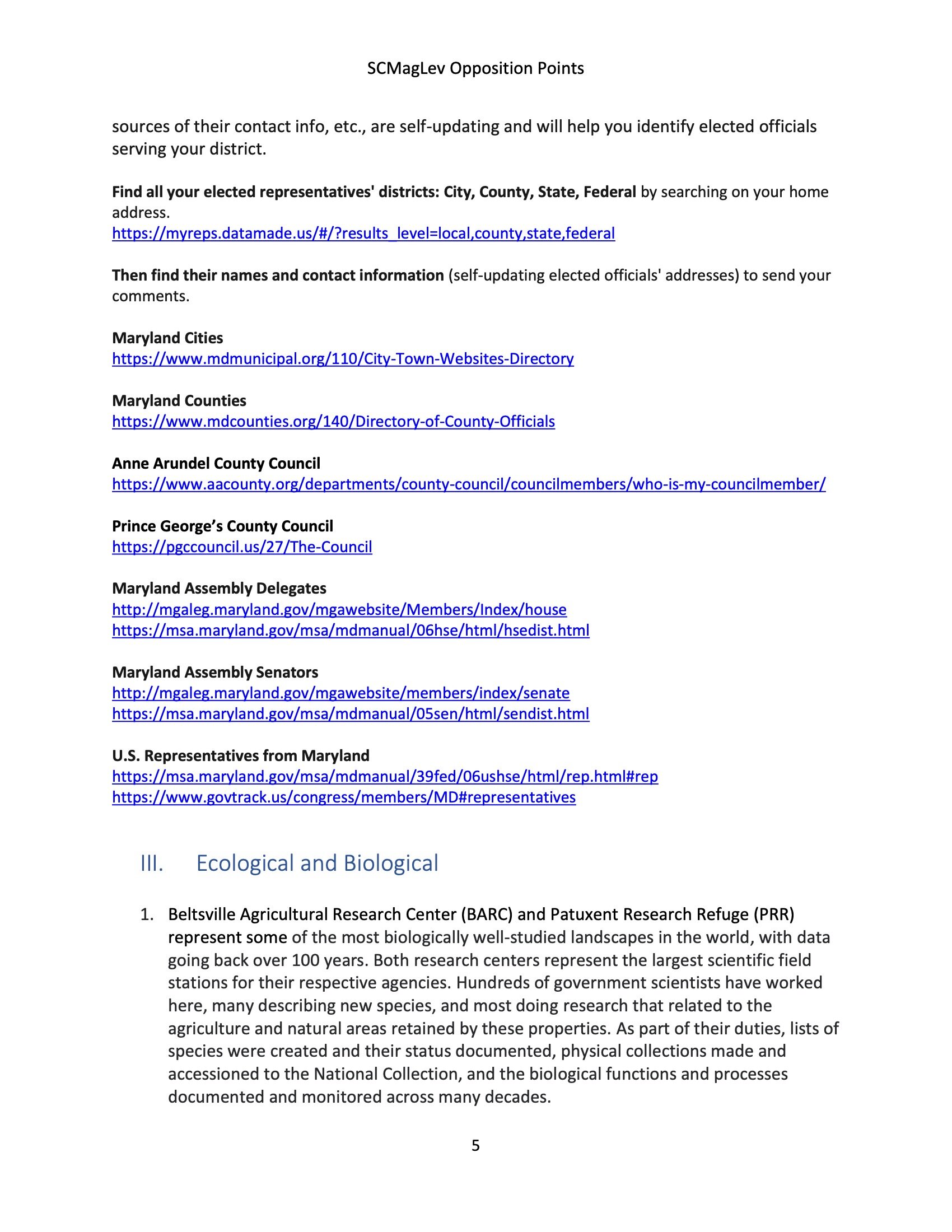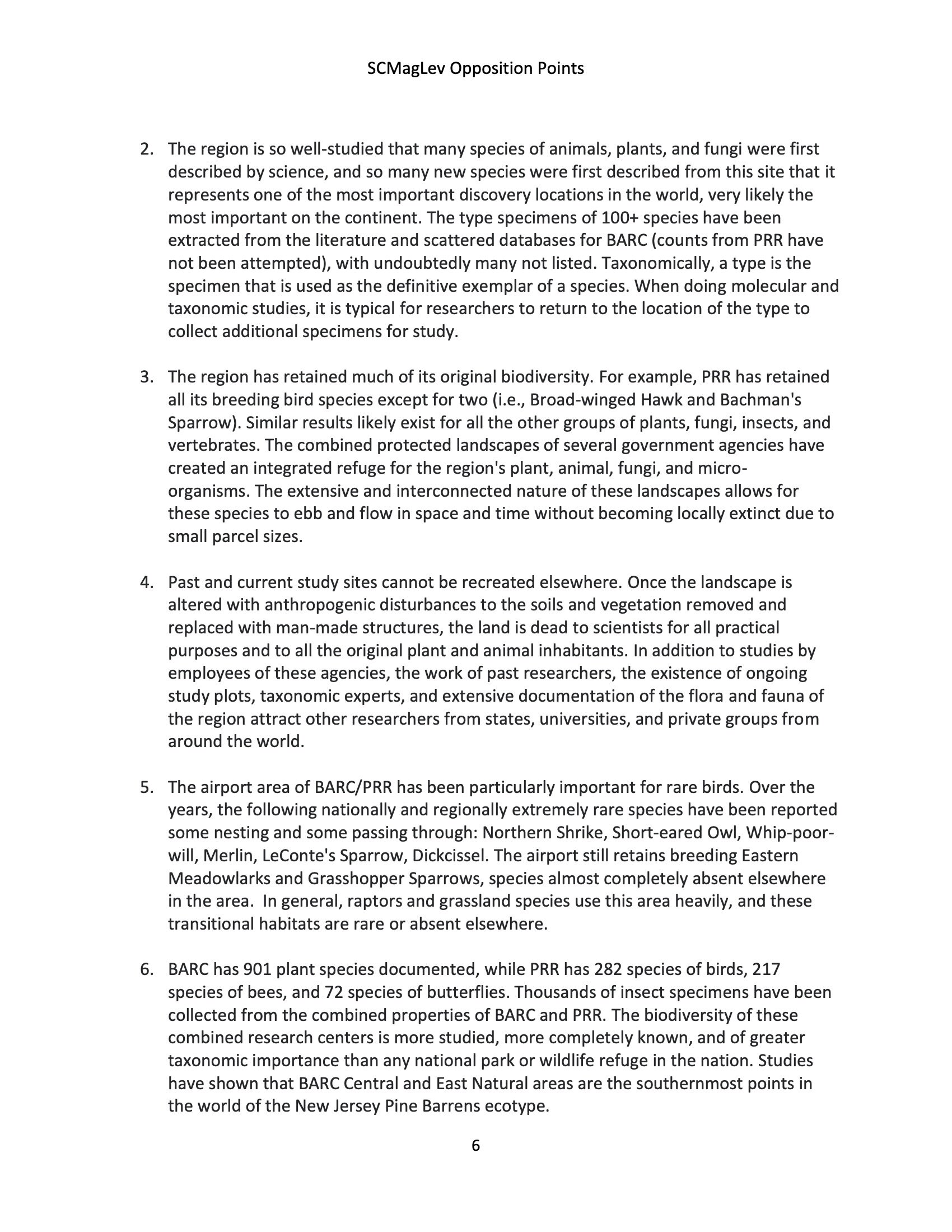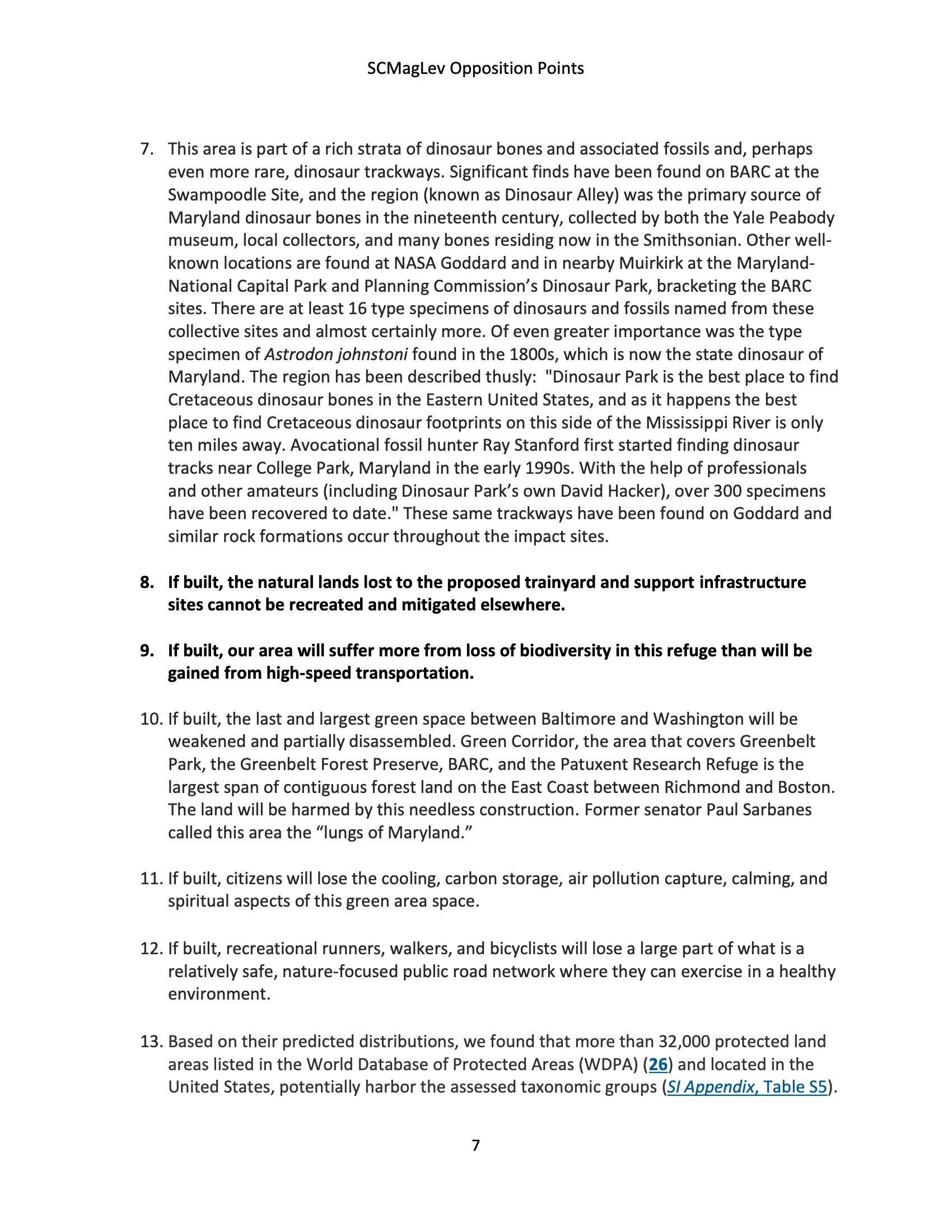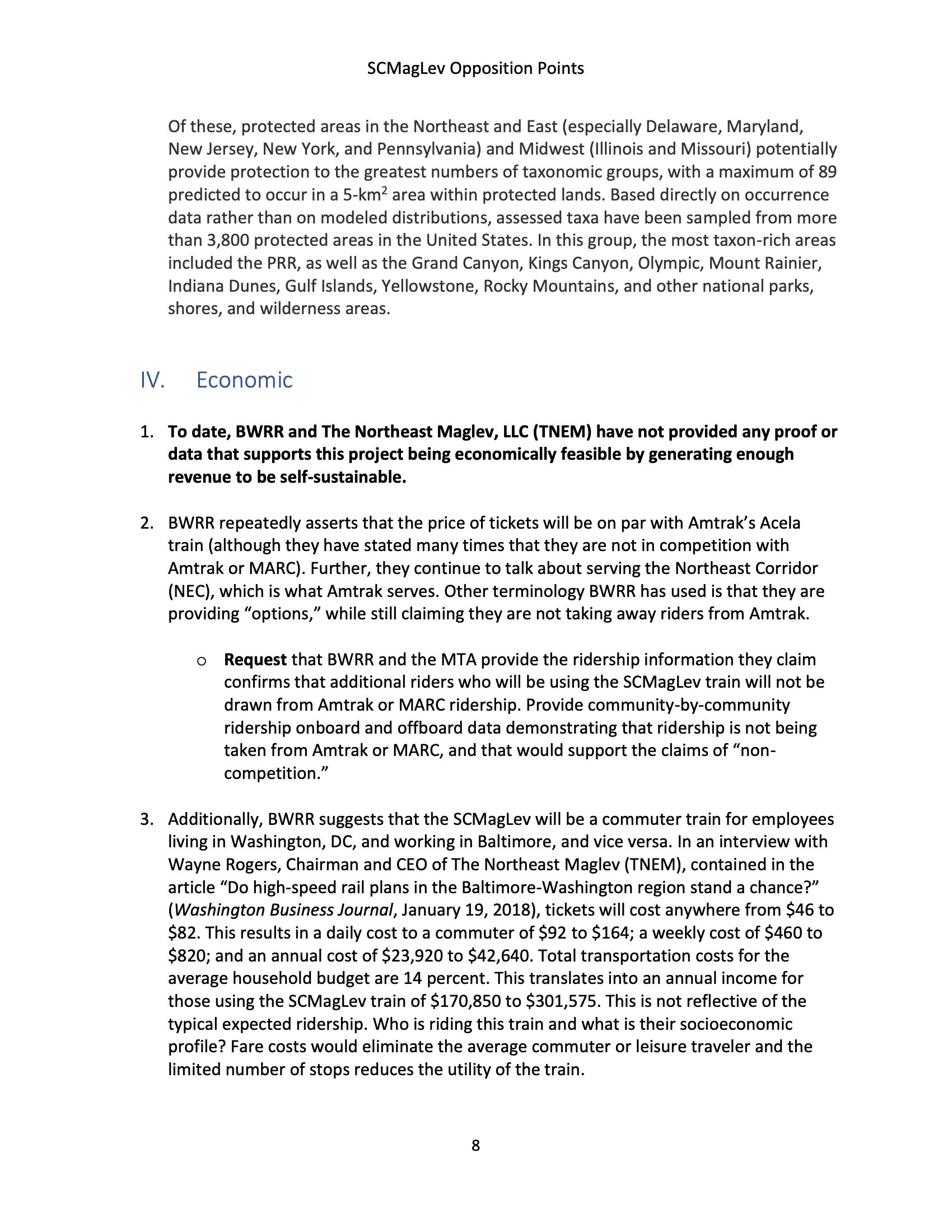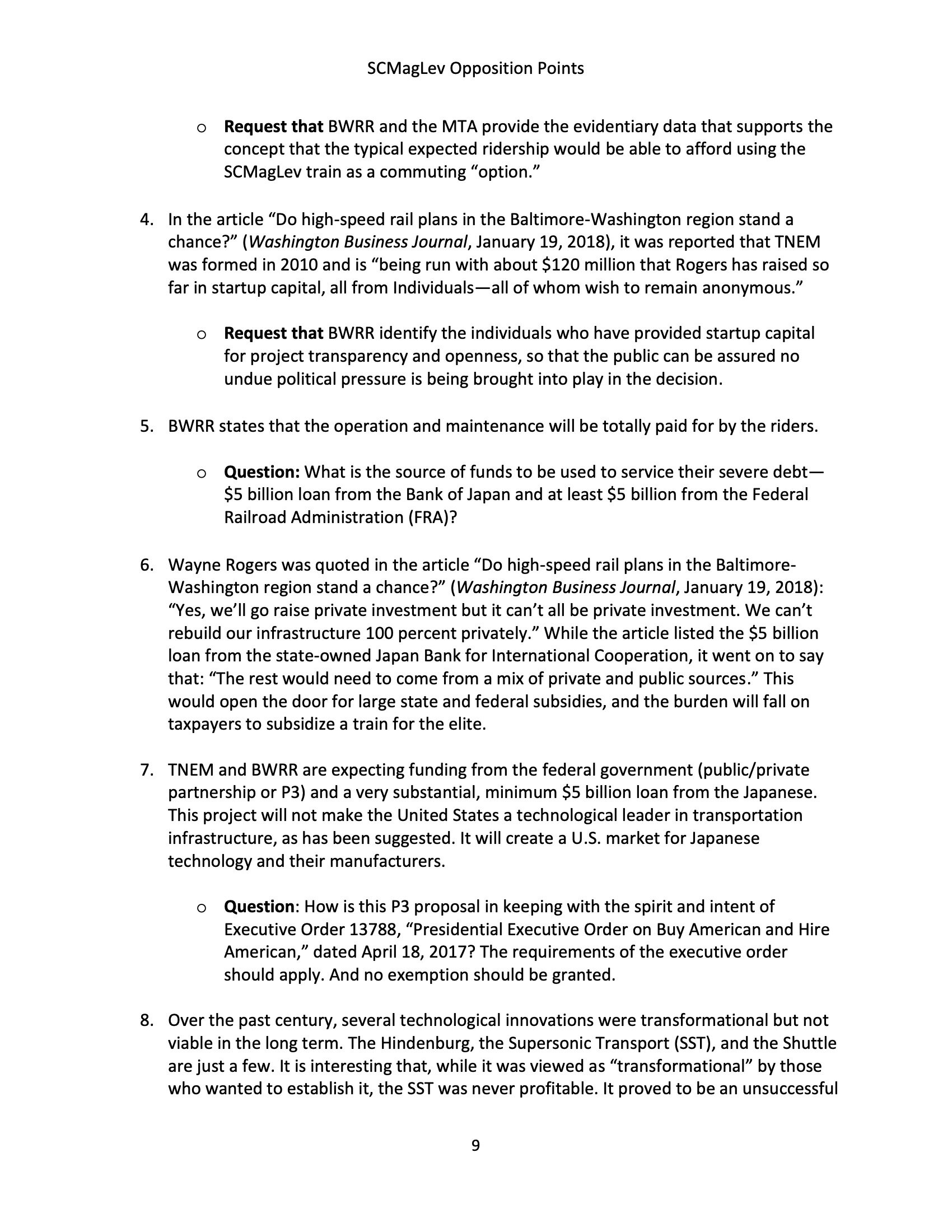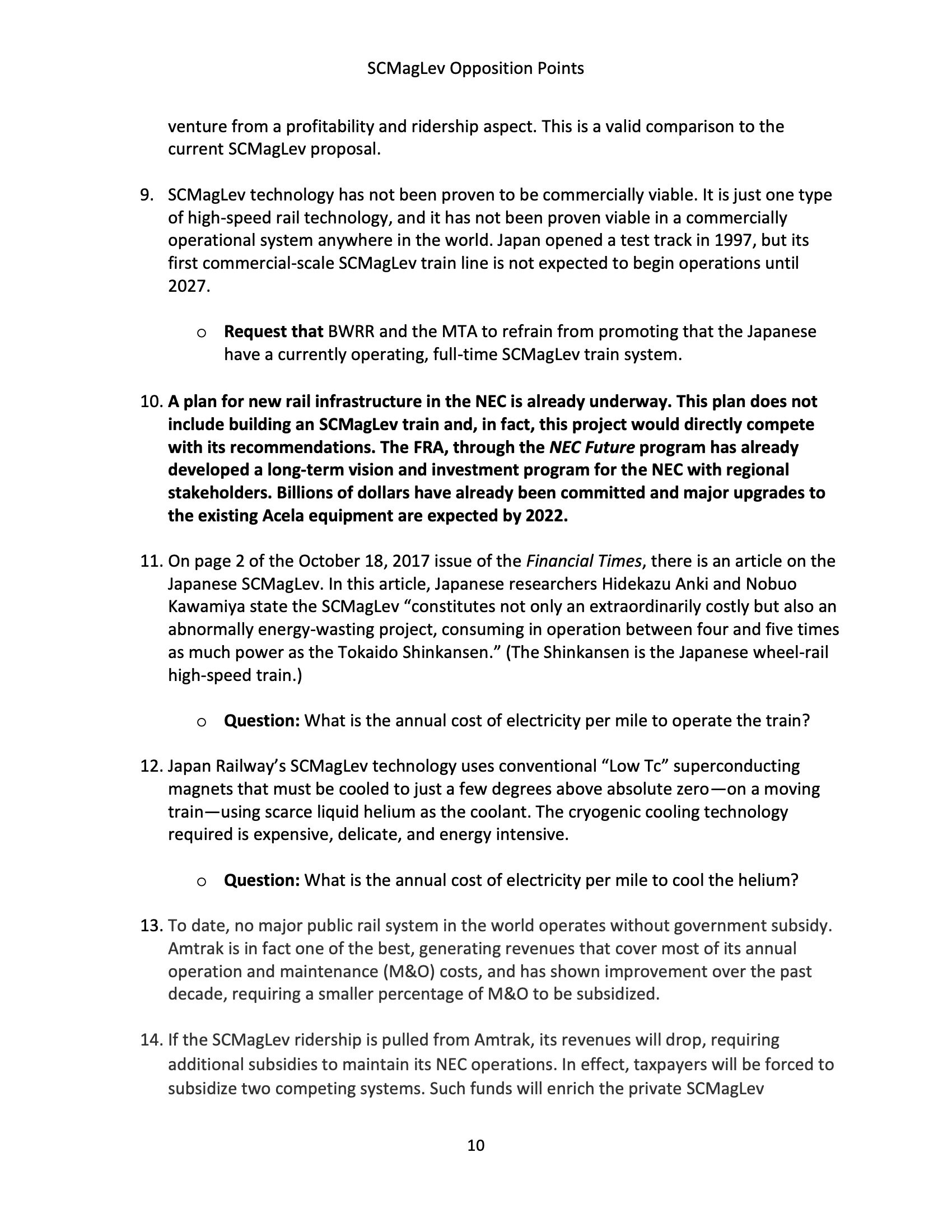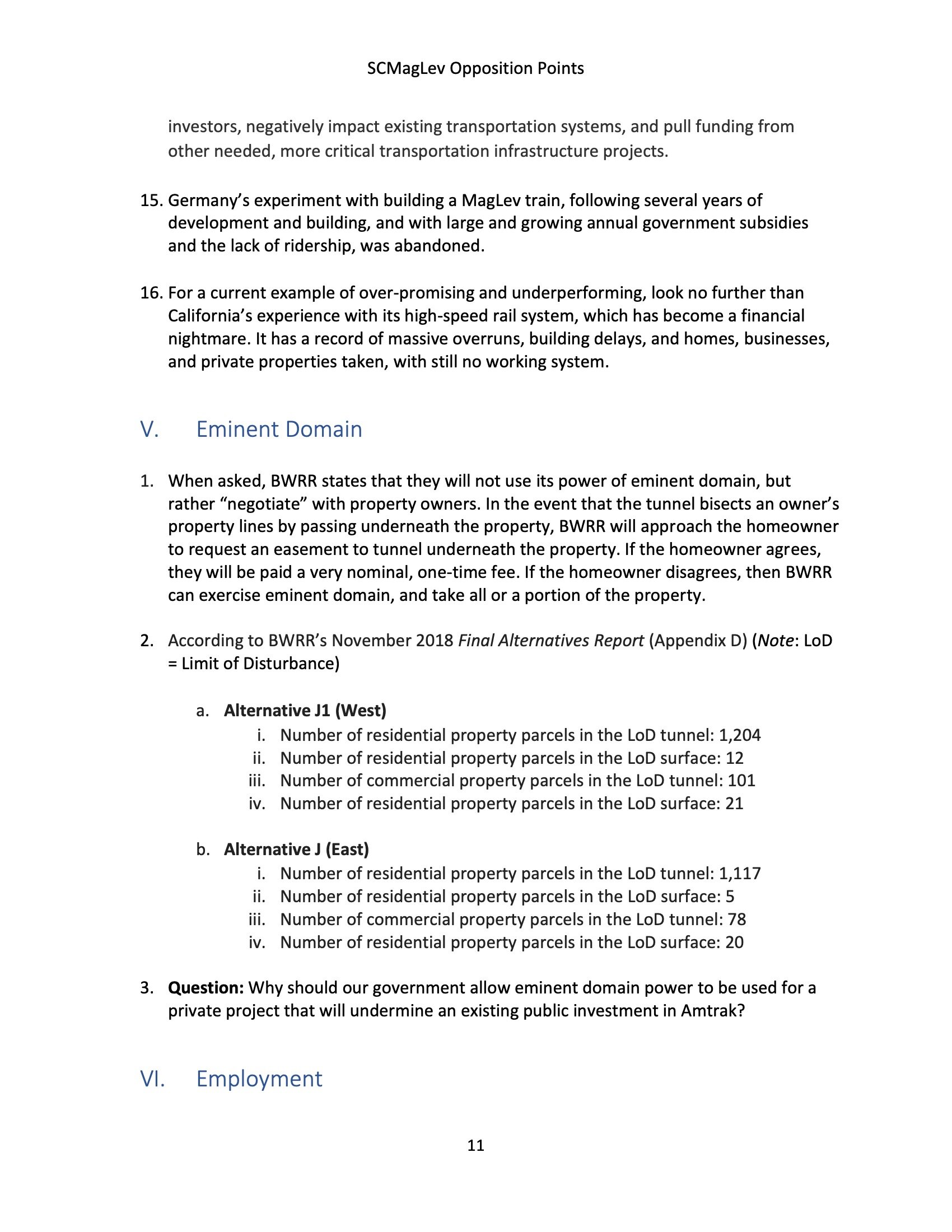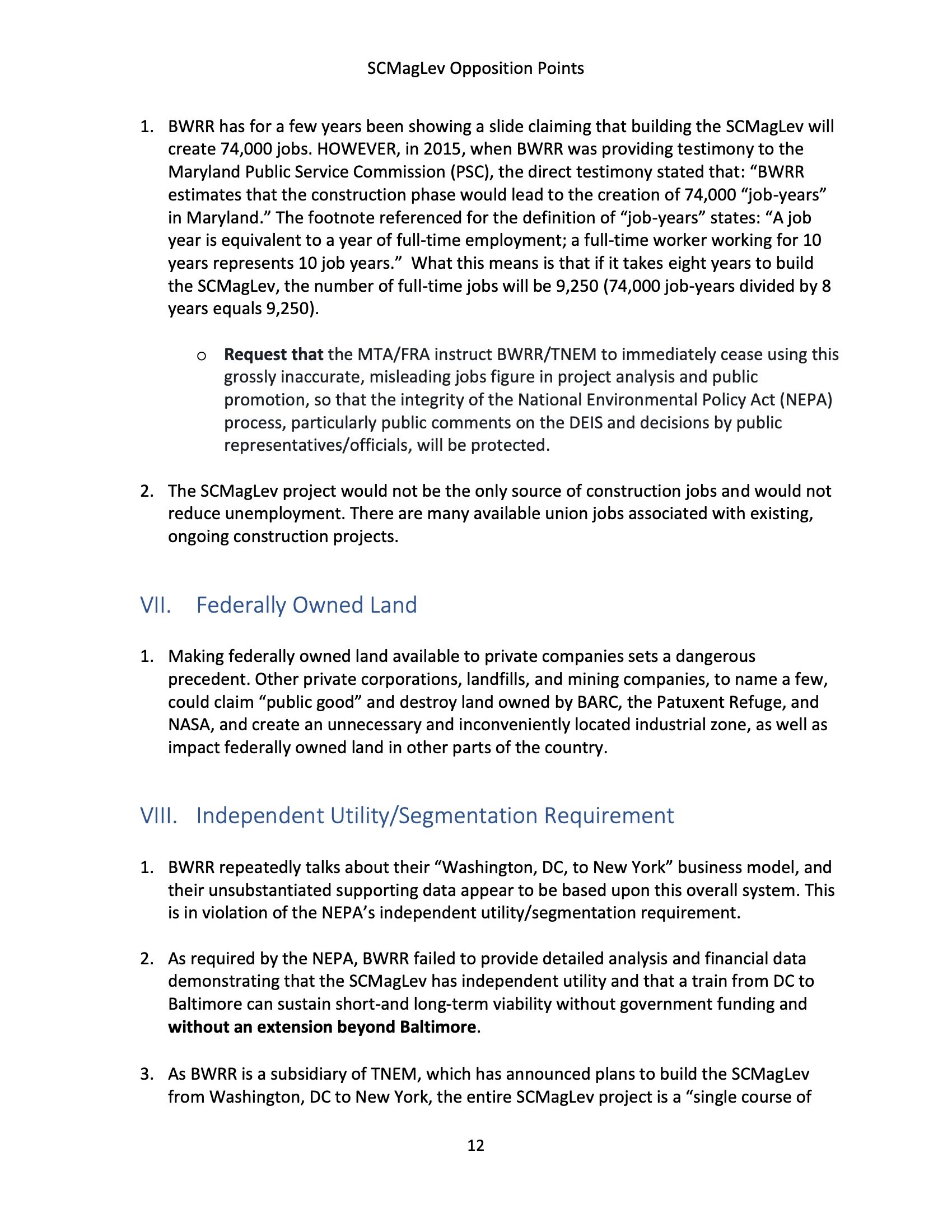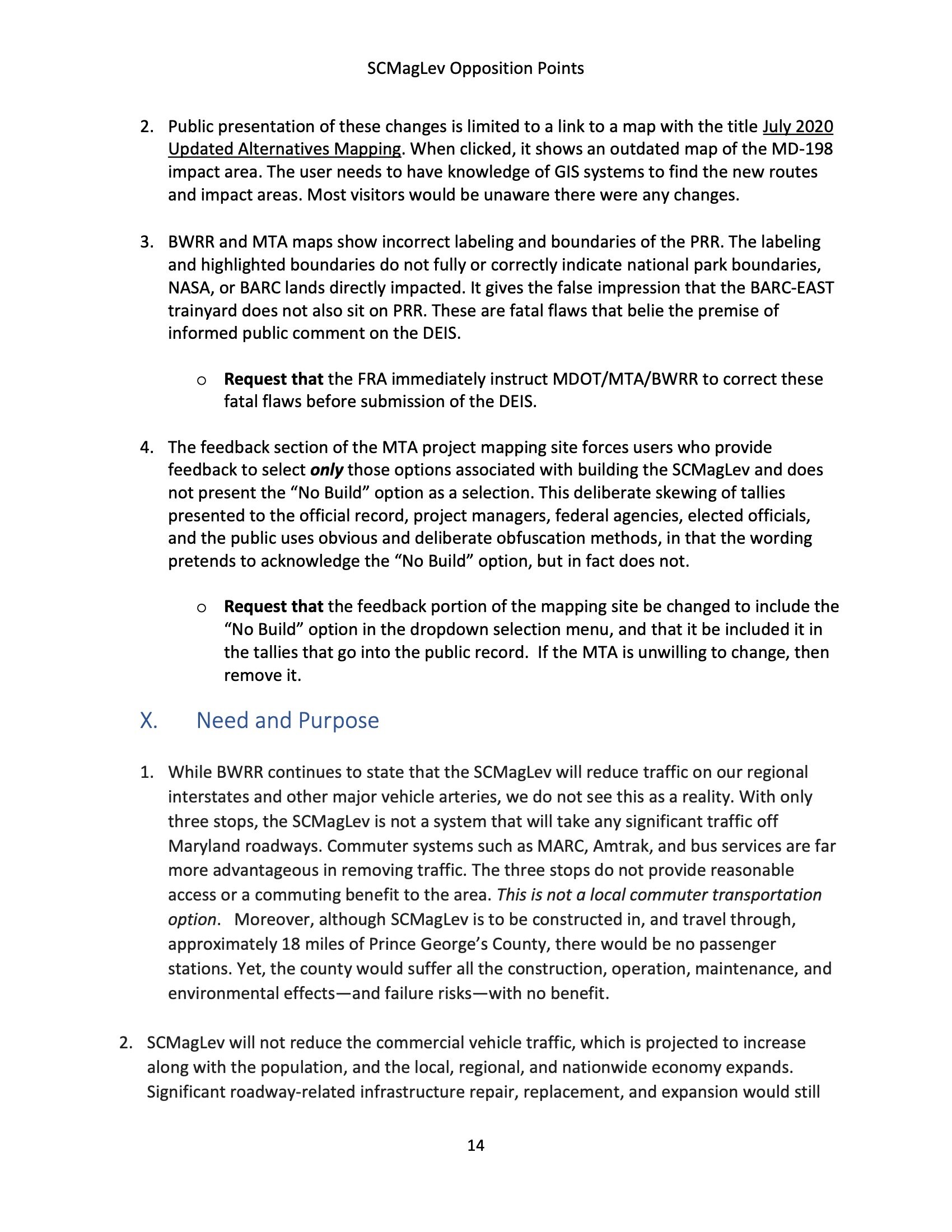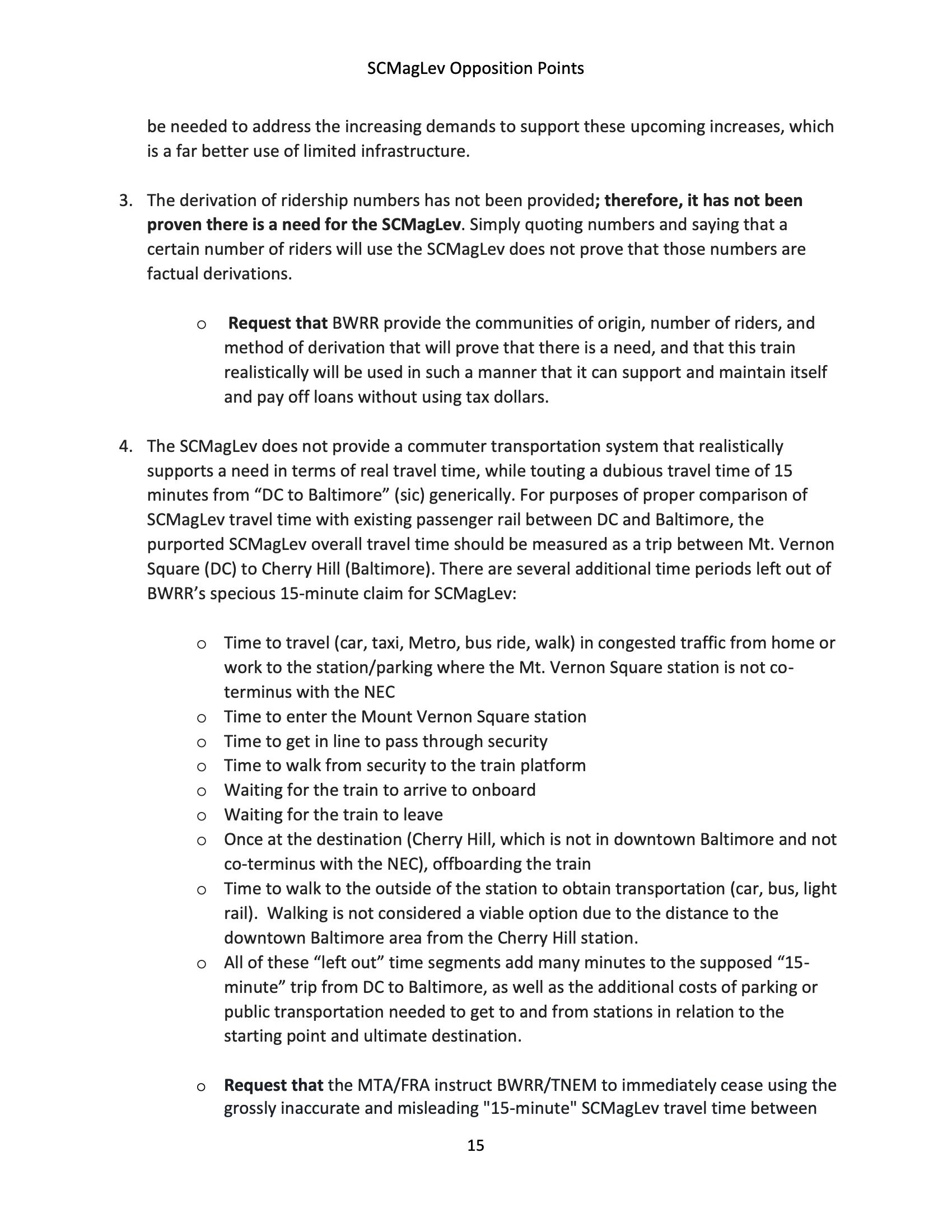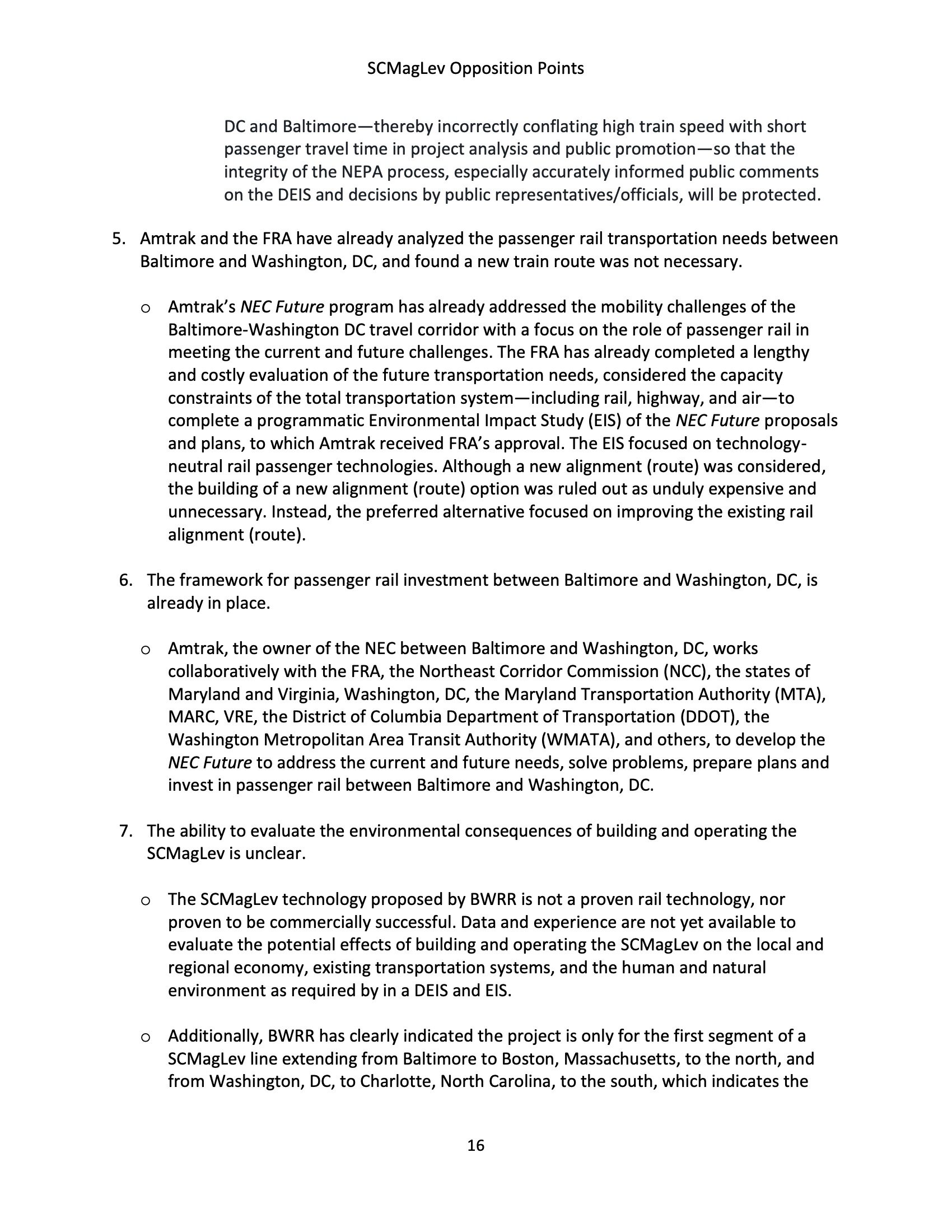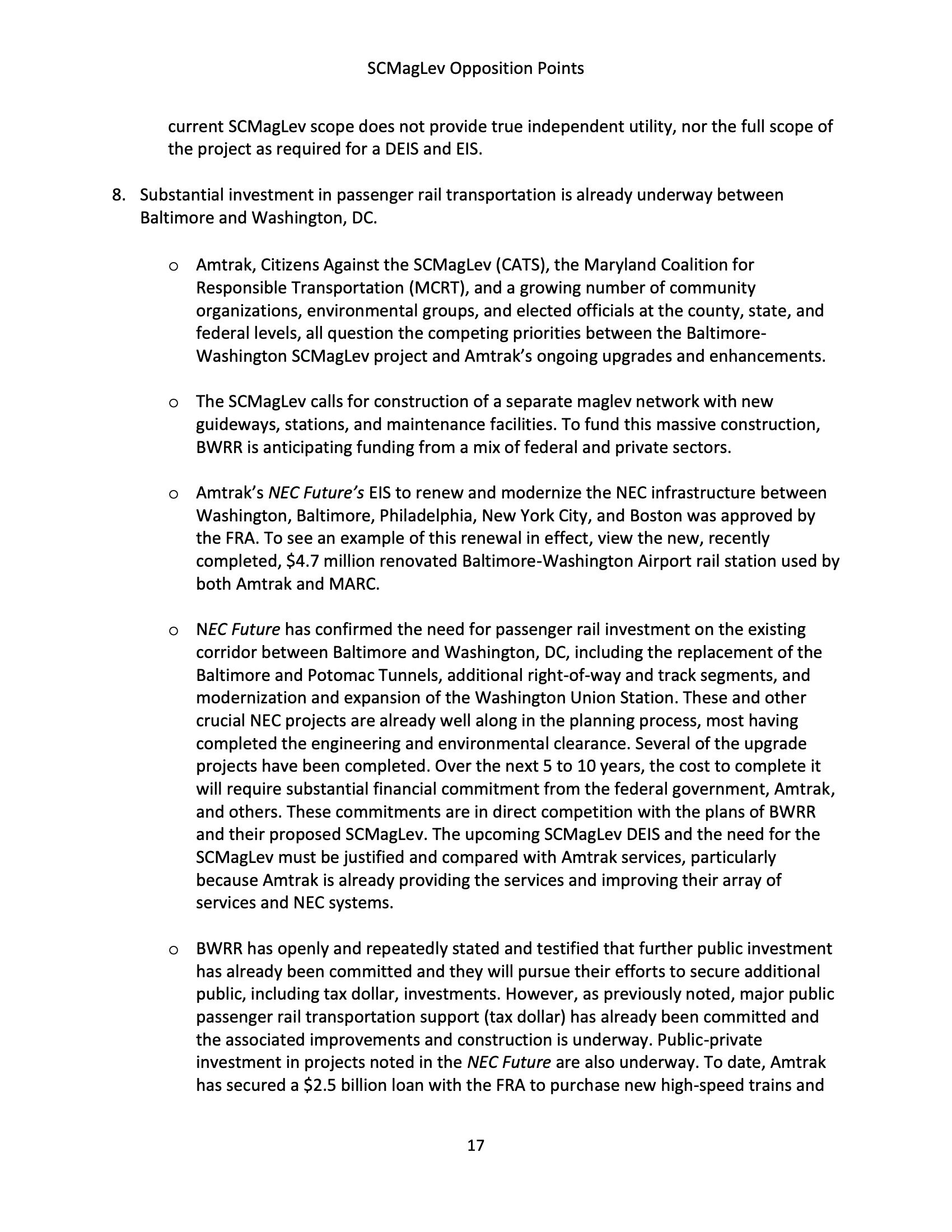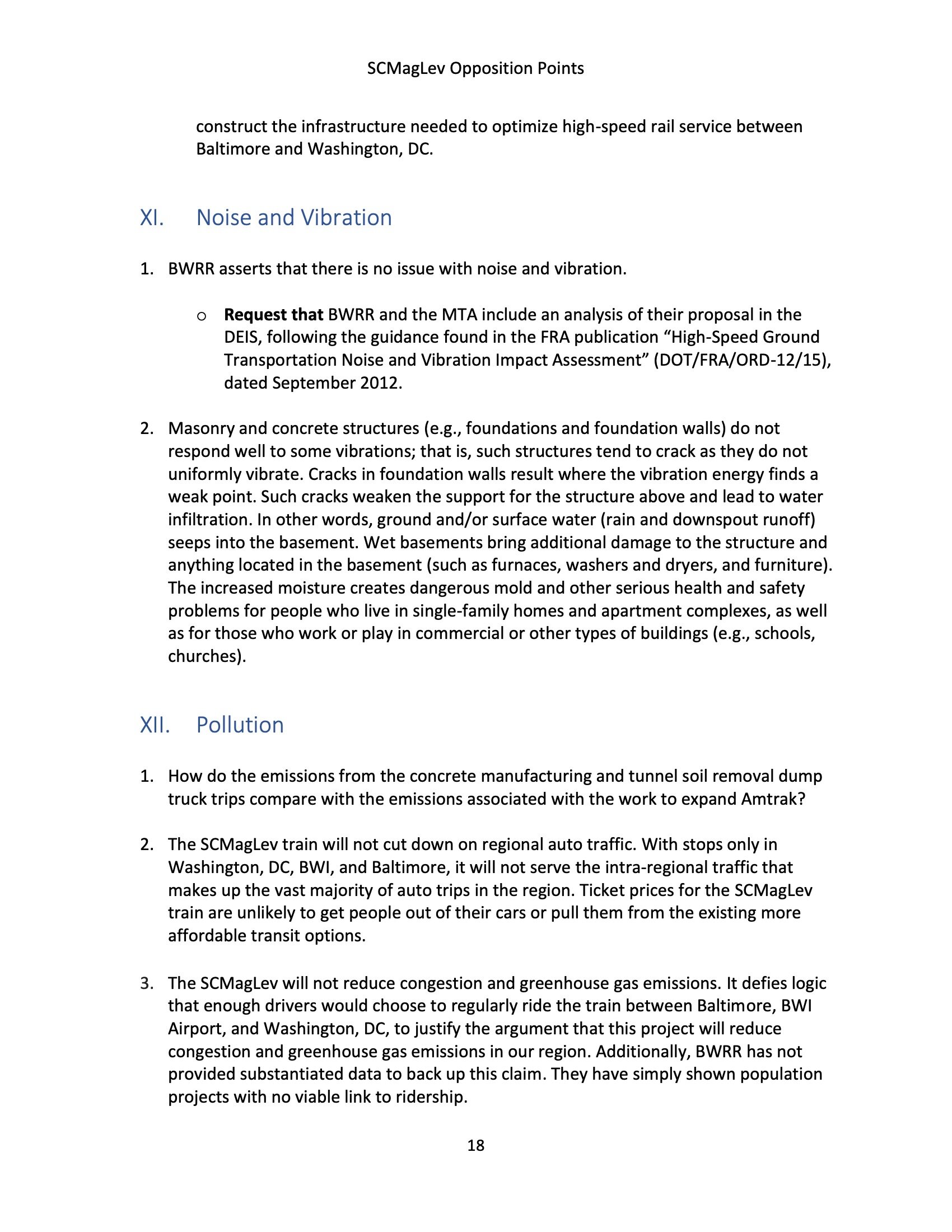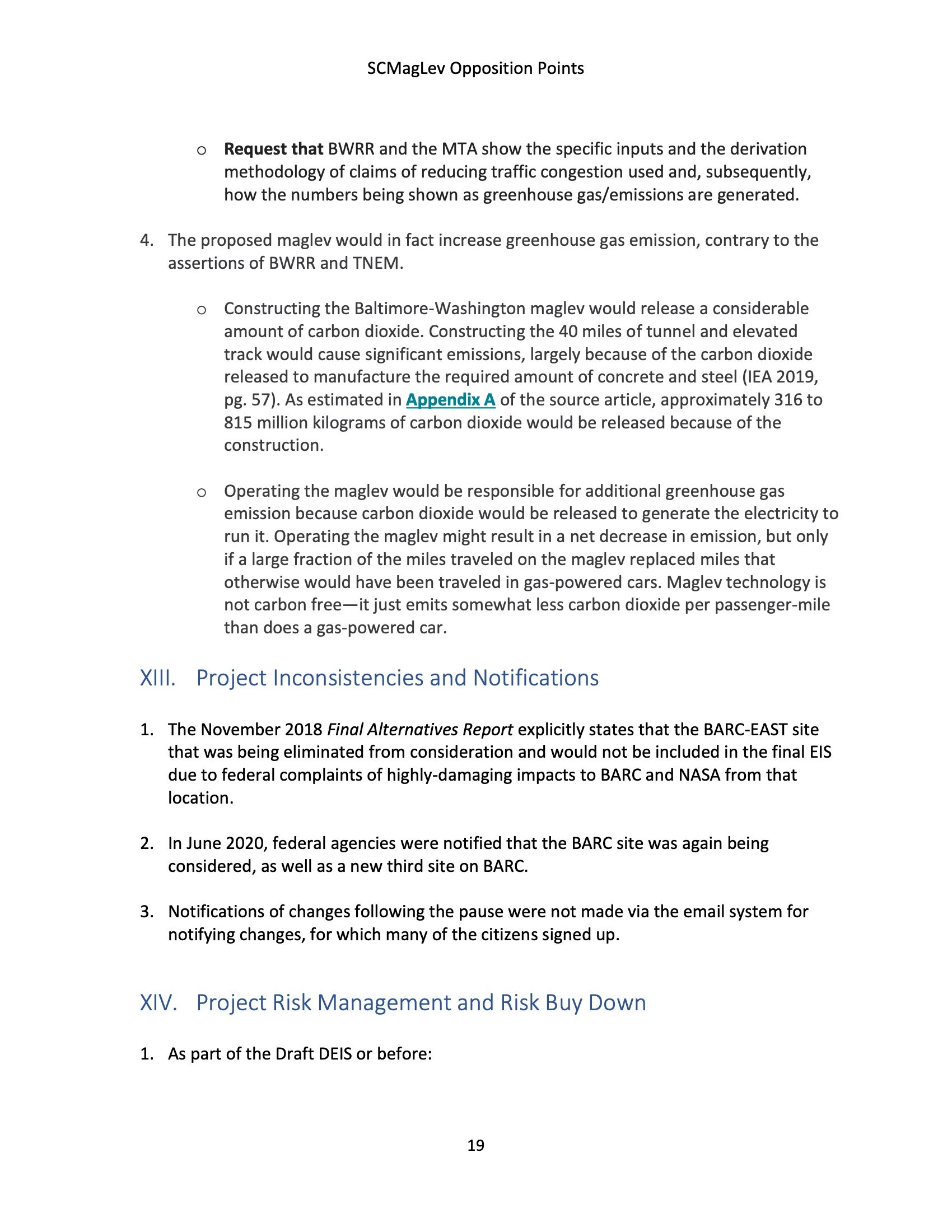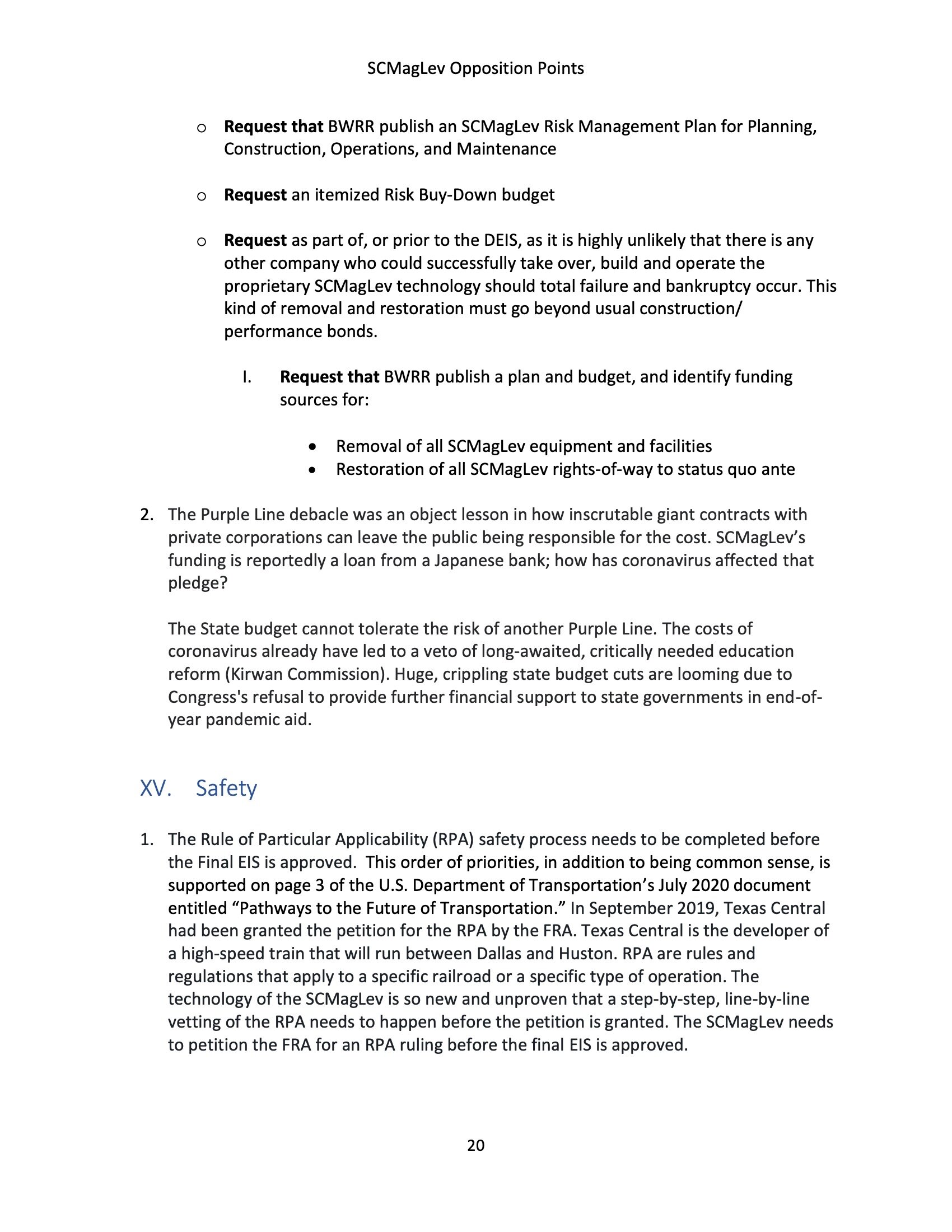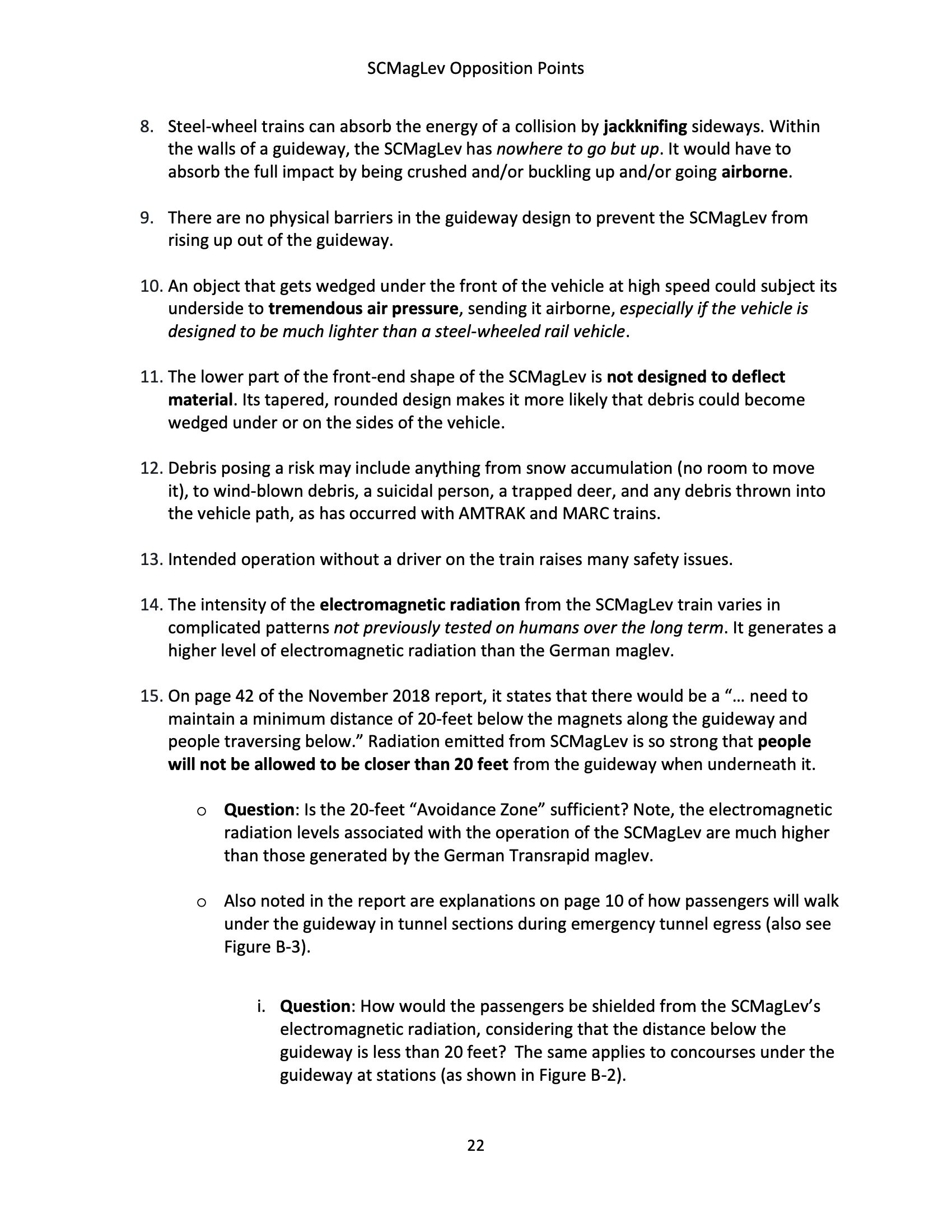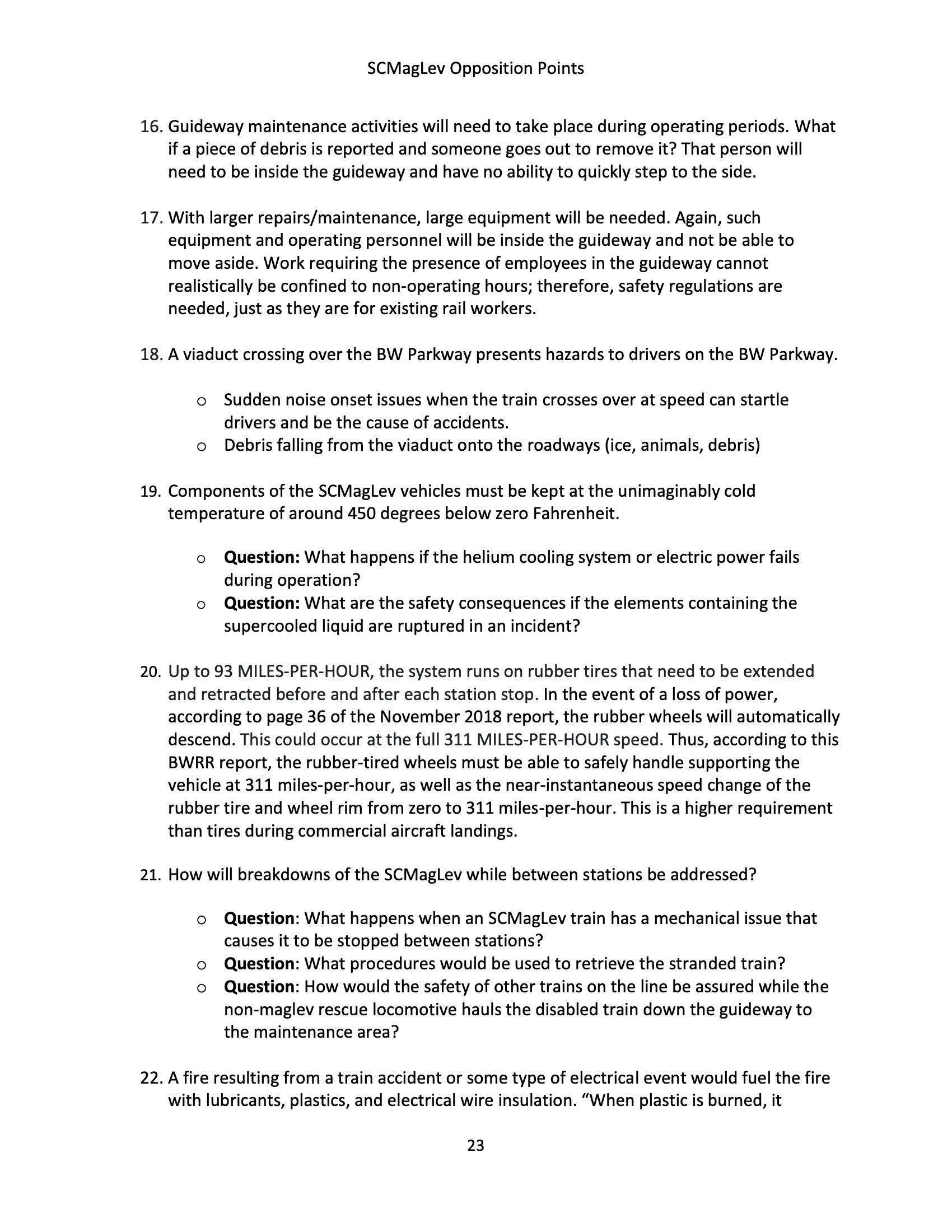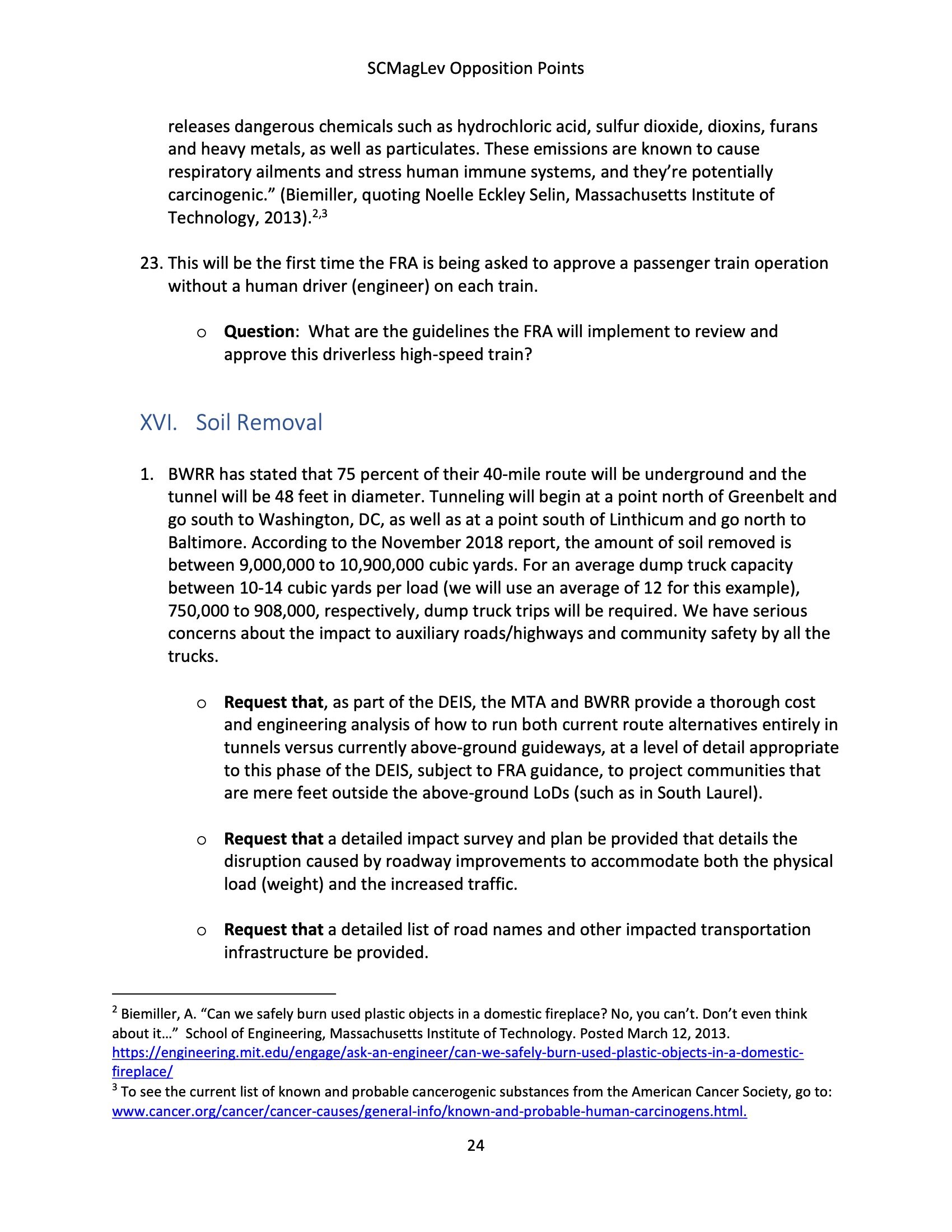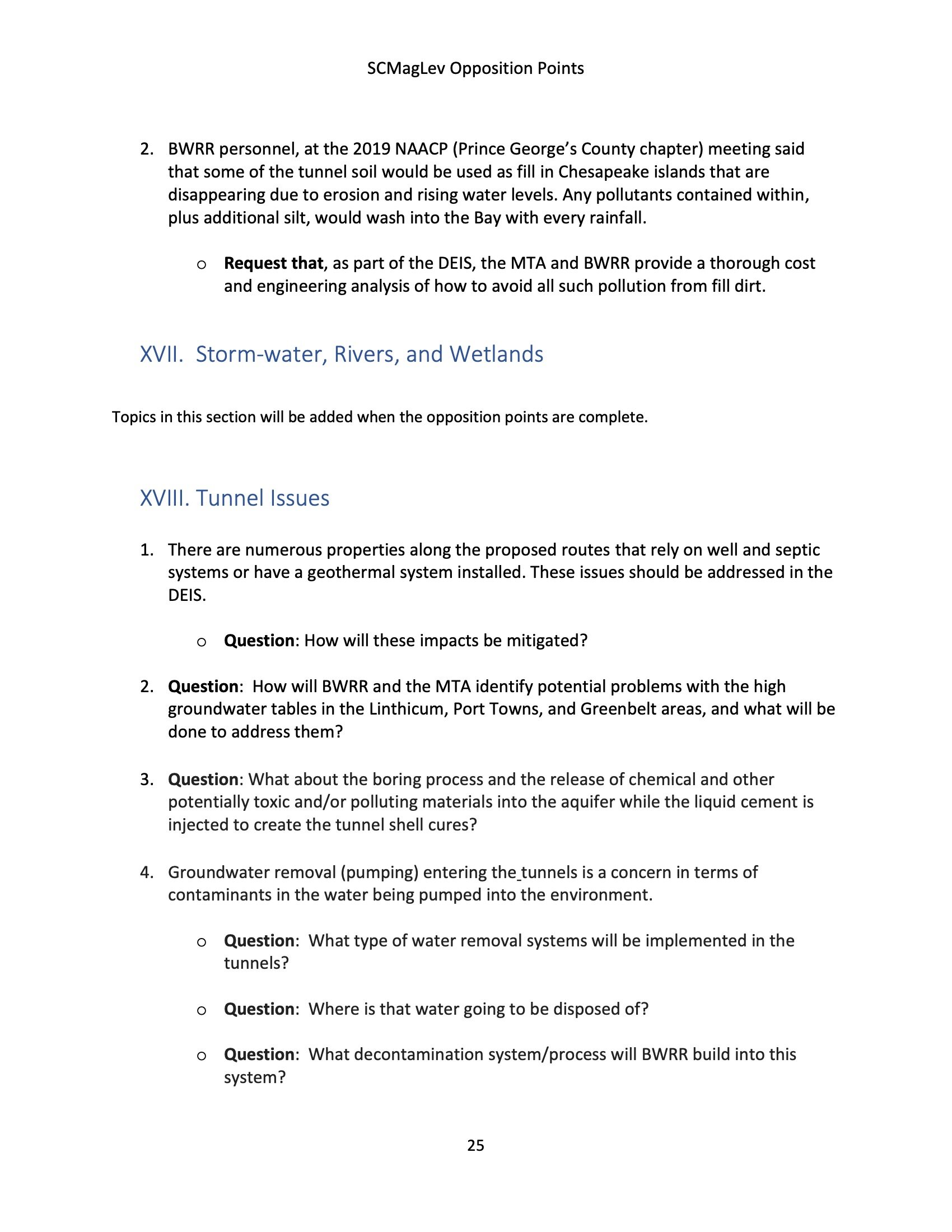LSIA Supports the Maryland General Assembly Senate Bill 200
Speaker: Dan Woomer, Vice President
Linthicum-Shipley Improvement Association (LSIA)
Hearing: Budget and Taxation and Education, Health, and Environmental Affairs
West Miller Senate Building
11 Bladen Street - Room 3
Annapolis, Maryland 21401
Date: Wednesday, February 6, 2019
Time: 1:00 p.m.
Summary:
The Linthicum-Shipley Improvement Association (LSIA) joins with Senators Pinsky and Peters to support this session’s Senate Bill 200 – “prohibiting the State and certain units and instrumentalities of the State from using any appropriation for a magnetic levitation transportation system in the State; prohibiting a public or private entity that receives money from the State from authorizing a permit or giving any other form of approval for a magnetic levitation transportation system in the State; prohibiting a proposal for a magnetic levitation transportation system from using certain right–of–way or track owned or operated by certain railroad companies; and generally relating to State appropriations for magnetic levitation transportation systems.”
Testimony:
Good afternoon. My name is Daniel E. Woomer, I’m the Vice President of the Linthicum-Shipley Improvement Association, also known as LSIA. I’ve lived in Linthicum over 39 years. I’m authorized to speak for our community association.
Thank you for scheduling this hearing and for the opportunity to speak with you in support of Senate Bill 200.
Linthicum, comprising the communities of North Linthicum, Linthicum, Crestwood and Linthicum-Shipley is a small town located south of Baltimore City, in Anne Arundel County. Our history dates back to the mid-1600’s as part of a land grant from England which led to the Linthicum and Shipley families establishing some of the earliest agricultural interests in our County. This farming area has evolved over the past centuries into a residential community.
Following the advent of train travel, our community became a place for lawyers, doctors, bankers, and others to move out of the city and into a more open and quiet community. Following WWII, Linthicum evolved into a suburb made up of residences, schools, our own fire station, our own post office, with small, medium and large businesses. Linthicum families typically come to stay, with many families having five or more generations rooted in our community. Of course, the Linthicum and Shipley families have far deeper roots. LSIA represents over 2,700 households and businesses, and has over 500 active household members. LSIA is opposed to the building of the SCMagLev and supports Senate Bill 200.
There are four principal reasons LSIA is opposed to building the SCMagLev: (1) It does not serve Marylanders, yet destroys our communities and green spaces. (2) It will generate Insufficient revenue requiring Government subsidies. (3) It will follow previous world experiences with such systems; many of which have failed or are being maintained with large government subsidies. (4) The need for other far more higher value transportation infrastructure improvements outweigh wasting funds on building the SCMagLev.
(1) SCMagLev Does Not Serve Marylanders, Yet Destroys Our Communities and Green Spaces.
Others will talk at greater depth of the impact of building the underground and elevated sections of the proposed SCMagLev from Baltimore, to BWI on onto Washington, DC. SCMagLev project will result in the:
• The destruction of swaths of homes, businesses, historic sights, and greenspaces through Prince Georges county with the erection of the elevated sections of the SCMagLev.
• The potential disruption of Anne Arundel aquifers.
• The potential release of toxins, carcinogens, and Radon gas into our communities collected in the SCMagLev tunneled sections through their surface ventilation facilities.
• Concerns of our schools’ structures, personal, and students on the impact of a high-speed oscillating magnetic field train running under them.
• Increased traffic with SCMagLev facilities and track maintenance equipment on I-95 and the BWI Parkway.
• One stop in Anne Arundel County, and no stops in Prince Georges County, virtually no benefit to the residents and businesses in our counties, yet we carry the burden of the destruction.
(2) SCMagLev Will Generate Insufficient Revenue Requiring Government Subsidies.
LSIA, as many others having followed the SCMagLev project for about two years, do not see how this system will generate the revenues needed to operate and maintain itself without the need for government subsidies. You all, as we, have received mixed signals for the SCMagLev leadership, one time saying all of the funds needed for maintenance and operation (M&O) will be generated by ridership, and another saying, any system like the one proposed requires a private and public support as in the use of tax dollars to provide financial support.
To date, no major public rail system in the world operates without government subsidy. Amtrak is actually one of the best, generating revenues which do cover the majority of its annual operation and maintenance (M&O) costs, and has shown improvement over the past decade, requiring a smaller percentage of M&O to be subsidized. If ridership is pulled from Amtrak by the SCMagLev, Amtrak revenues will drop requiring represents over 2,700 households and businesses, and has over 500 active household members. LSIA is opposed to the building of the SCMagLev and supports Senate Bill 200. There are four principal reasons LSIA is opposed to building the SCMagLev: (1) It does not serve Marylanders, yet destroys our communities and green spaces. (2) It will generate Insufficient revenue requiring Government subsidies. (3) It will follow previous world experiences with such systems; many of which have failed or are being maintained with large government subsidies. (4) The need for other far more higher value transportation infrastructure improvements outweigh wasting funds on building the SCMagLev. (1) SCMagLev Does Not Serve Marylanders, Yet Destroys Our Communities and Green Spaces. Others will talk at greater depth of the impact of building the underground and elevated sections of the proposed SCMagLev from Baltimore, to BWI on onto Washington, DC. SCMagLev project will result in the: • The destruction of swaths of homes, businesses, historic sights, and greenspaces through Prince Georges county with the erection of the elevated sections of the SCMagLev. • The potential disruption of Anne Arundel aquifers. • The potential release of toxins, carcinogens, and Radon gas into our communities collected in the SCMagLev tunneled sections through their surface ventilation facilities. • Concerns of our schools’ structures, personal, and students on the impact of a high-speed oscillating magnetic field train running under them. • Increased traffic with SCMagLev facilities and track maintenance equipment on I-95 and the BWI Parkway. • One stop in Anne Arundel County, and no stops in Prince Georges County, virtually no benefit to the residents and businesses in our counties, yet we carry the burden of the destruction. (2) SCMagLev Will Generate Insufficient Revenue Requiring Government Subsidies. LSIA, as many others having followed the SCMagLev project for about two years, do not see how this system will generate the revenues needed to operate and maintain itself without the need for government subsidies. You all, as we, have received mixed signals for the SCMagLev leadership, one time saying all of the funds needed for maintenance and operation (M&O) will be generated by ridership, and another saying, any system like the one proposed requires a private and public support as in the use of tax dollars to provide financial support. To date, no major public rail system in the world operates without government subsidy. Amtrak is actually one of the best, generating revenues which do cover the majority of its annual operation and maintenance (M&O) costs, and has shown improvement over the past decade, requiring a smaller percentage of M&O to be subsidized. If ridership is pulled from Amtrak by the SCMagLev, Amtrak revenues will drop requiring additional subsidies to maintain the Northeast corridor. In effect, taxpayers will be forced to subsidizing two competing systems. Such funds will enrich the private SCMagLev investors, negatively impact existing transportation systems, and pull funding from other needed more critical transportation infrastructure projects.
(3) SCMagLev Will Follow Previous World Experiences with Such Systems, Many of Which Have Failed or are Being Maintained with Large Government Subsidies.
I call your attention to a recent report by Ms. Carol Park, an analyst at the Center for Business and Economic Competitiveness at the Maryland Public Policy Institute titled: Lessons from Asia for the Northeast SCMagLev.
To quote Ms. Park - “SCMagLev enthusiasts have been pushing the project despite warnings of significant risks, just like the supporters of the bullet train did in Asia. For instance, the South Korean government built the Seoul-Incheon line despite consistent warnings of inadequate demand. The project was politically, rather than commercially, driven as Korean officials wanted to present a futuristic version of Korea to the international community as part of the 2018 Pyeongchang Winter Olympics.” The line was closed in 2018 after just four years of service because 77 percent of seats were unoccupied.
Germany’s experimented with building a MagLev train, and following several years of development and building, with large and growing annual government subsidies and the lack of ridership, the effort was abandoned.
For a current example of over promised and underperformance, look no further than California’s experience with high speed rail system, which has become a financial nightmare. Massive overruns, building delays, homes, businesses and private properties taken, and still no working system.
Ms. Park states: “Supporters of SCMagLev dismiss these concerns. They argue that the success of bullet trains in Japan demonstrate that these hurdles can be overcome. That’s exactly what officials in China, Taiwan and South Korea thought, only to discover that the situation in Japan is unique. Most of Japan’s 128 million inhabitants live in a few densely populated cities. Many of those residents are rich enough to afford expensive train tickets.”
Note, SCMagLev officials have repeated stated that the ticket prices will be similar to Amtrak/Acela.
“Compared to Japan, the situation is the polar opposite in Baltimore, where many of the residents who depend on public transit are low-income workers. If these residents are to commute between Baltimore and D.C., they would need an option that is affordable and easily accessible from their homes.” The SCMagLev is neither. Whereas, MARC provides that reliable and cost-effective transportation system: last year moving well over 8 million passengers into and out of DC.
(4) The Need for Other Far High Value Transportation Infrastructure Improvements Outweigh Wasting Funds on Building the SCMagLev.
Supporters of the SCMagLev state the existing 150-year-old system is out of date and employs obsolete technology. Well, I rode MARC and Amtrak into DC for nearly 30 years, and not once was I on a train that employed a wood fired steam engine. Amtrak and MARC employ modern equipment, running on an upgraded high-speed rail system. Both are purchasing and implementing new, proven, state-of-the-art equipment.
Amtrak has just completed a multi-year Environmental Impact Study (EIS), secured loans totaling $2.7 Billion, and are actively engaged in upgrading rail, equipment and stations all along the Northeast corridor. Note – Maryland’s own BWI Rail Station is currently being replaced with a larger, modern, new tech, and improved comfort building.
Instead of wasting money to build a transportation system that will not serve Marylanders, and take funds needed for transportation infrastructure, LSIA and many others believe it would be far better to invest those funds into Maryland transportation infrastructure.
For example - Look around this room. Everything you see – the structure, paint, electrical, electronics, furniture, the clothes and shoes we are all wearing, all were transported by commercial truck. Maryland commerce requires sound transportation infrastructure to operate efficiently. Such systems draw business to Maryland and improve the economic base of our State. How many Maryland bridges are rated C or lower, and are in need of repair or replacement? Such work would be a far better use of Maryland’s tax dollars than investing in and subsidizing an unnecessary high cost train for the well healed.
AND . . . We haven’t spoken to security concerns associated with having a 300 plus mile an hour train flying down an elevated section of track, or through a tunnel. What catastrophic results would occur if someone manages to get to the track and execute an attack. Who is going to maintain the security envelop, and how much resources will the State and Counties be required to provide? All costing additional tax dollars better used elsewhere.
In conclusion, I agree with the Center for Business and Economic Competitiveness at the Maryland Public Policy Institute report recommendation – “The Northeast Maglev project should be scrapped before it is too late. There are many transportation priorities that are worthier of attention.” Again, thank you for this opportunity to testify at this hearing. I have provided a printed copy of my testimony for your review and records, with a copy of the Center for Business and Economic Competitiveness at the Maryland Public Policy Institute’s report for your convenience.
Again, thank you for this opportunity to testify at this hearing.
